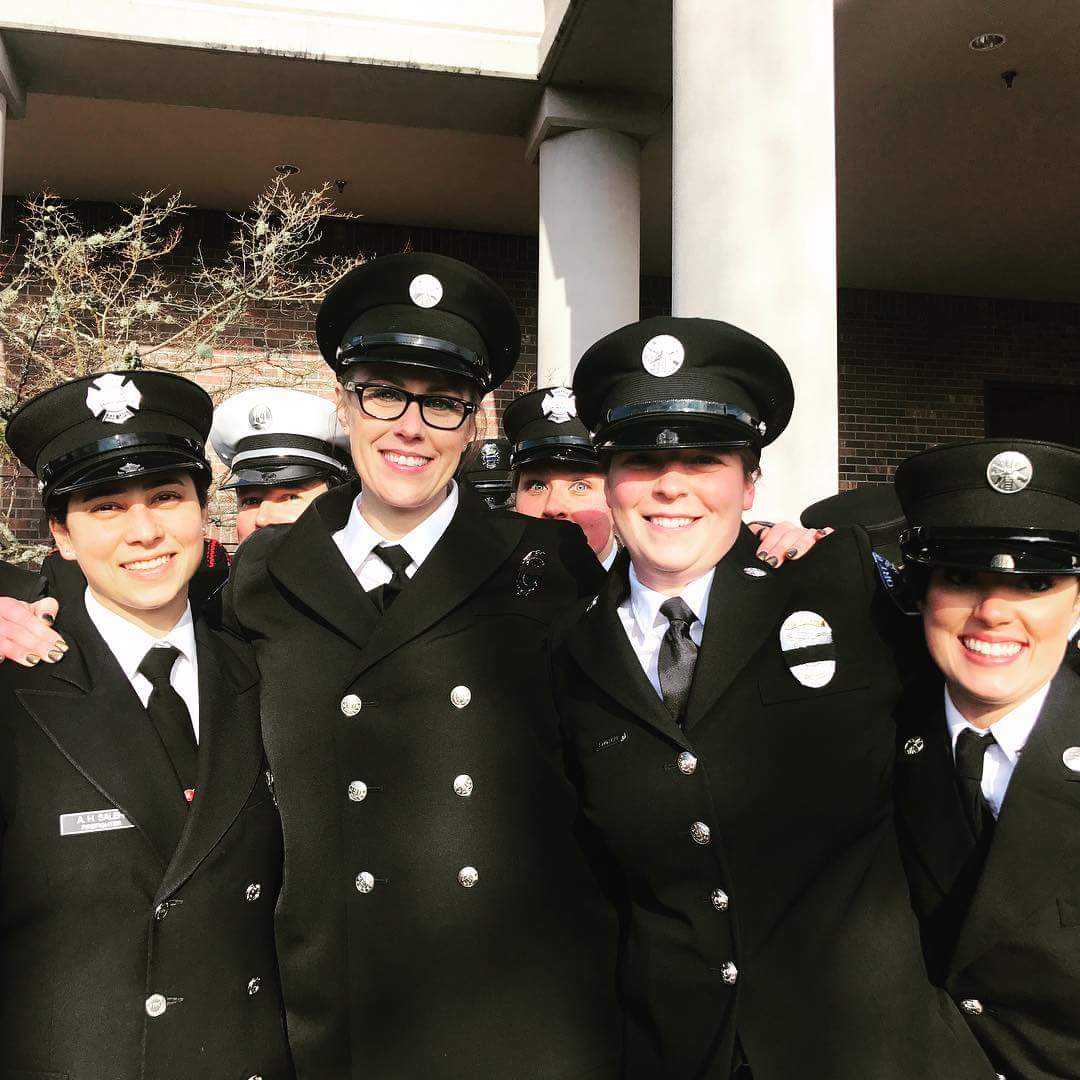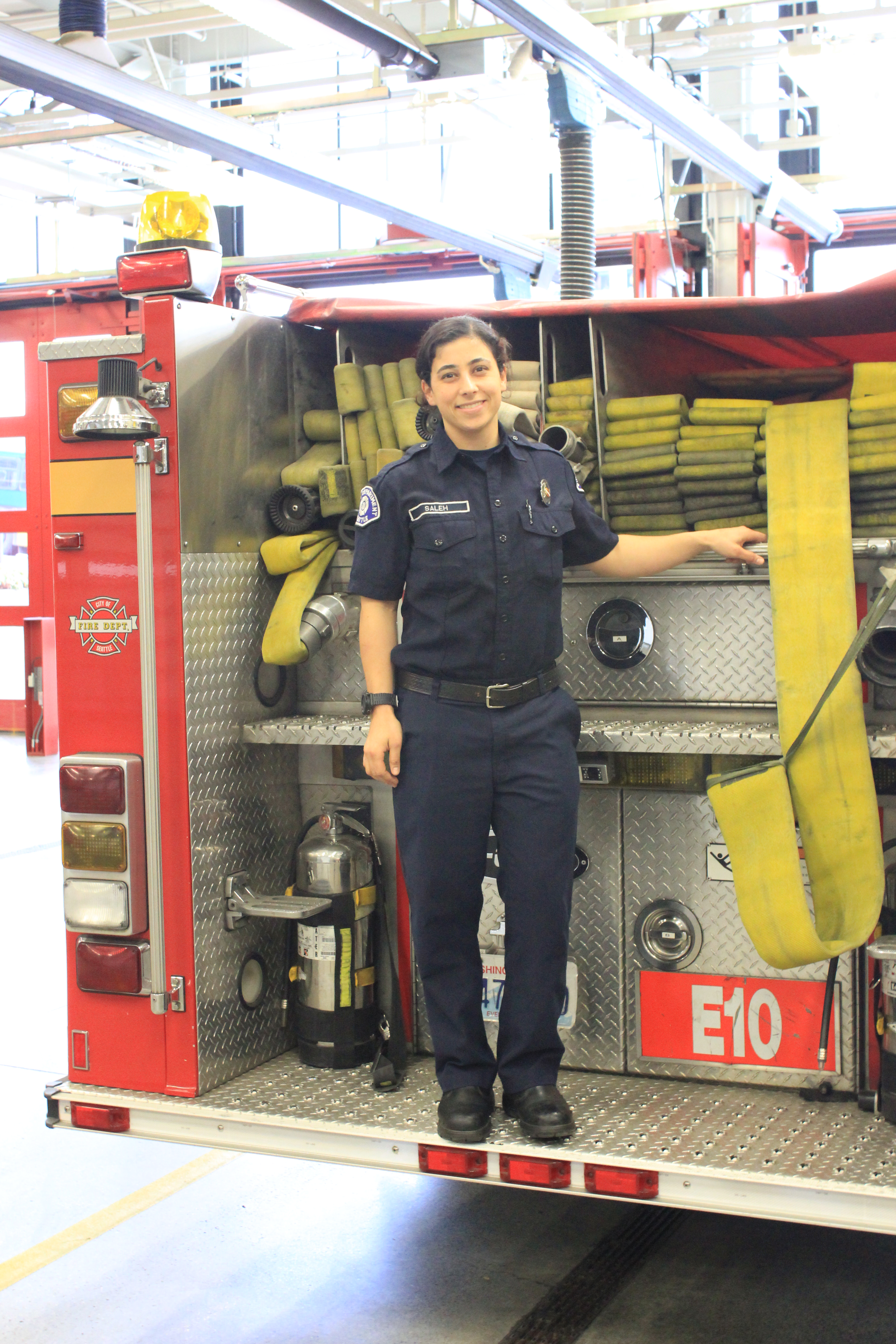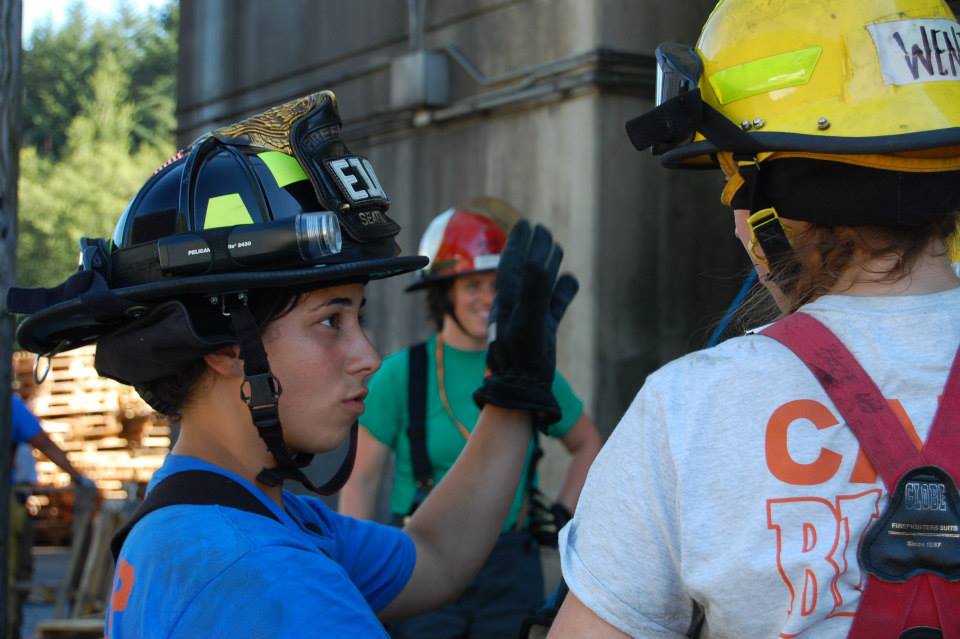By Carla J. Kimbrough
When Amina Saleh was 4 years old, she was hit by a car. Firefighters – tall, big guys, their faces framed with blond and brown hair – rescued her. From that time on, she became obsessed with fire engines. She grew up thinking firefighters were cool.
Just over a decade later, 16-year-old Saleh was thumbing through a teen magazine when she saw something that would change her life – an ad for Camp Blaze in Washington state. She applied and got accepted.
It was billed, Saleh said, as a free camp “where young women could experience what a career in the fire service might be like.” And it was fun. The campers performed skits and played leadership games. The shy, awkward girls found friends. They were given tools and tasks and later learned how they could be used in firefighting – like the first time Saleh was handed a chainsaw.
With each speaker – a woman working as a firefighter – Saleh thought to herself, “She’s the coolest person I’d ever seen.” By camp’s end, she felt, “I had all these role models.” Until then, she had never considered that women could be firefighters too.
“As a teenager, I got to see the finished product.”
That was 2003. In the years since, Saleh she has been making career moves – volunteer firefighter, an EMT, fire explorer, a fire cadet, and a firefighter – first in a suburban Seattle fire department. Now, she worked her way up to her current position – firefighter and EMT with the Seattle Fire Department. She said she owes her confidence to pursue this career to those early years with Camp Blaze.
“Without that experience, I don’t know if I have the courage.”

Efforts such as Camp Blaze are occurring across the country. The events come in all shapes and sizes – one day, weekend, overnight, or daytime only. Some born of collaboration among several fire departments and one – reaching children as young as kindergarten – was built with help from the Girl Scouts.
The cities, metropolitan areas, states, and even regions that have organized these camps are Portland, Oregon; Yuma, Arizona; Oklahoma City, Oklahoma; Madison, Wisconsin; Charlotte, North Carolina; Utica, New York; Concord, New Hampshire; and Massachusetts.
Regardless of duration or location, the aim is the same: bring more women into the fire service. These programs show girls and women a career they may not have considered. Some departments are using targeted recruitment to attract not only women but also people of color to careers in fire and policing.
Local governments nationwide are wrestling with how to bring more people of color and women into the fire safety and law enforcement fields. Some city leaders charged with increasing the diversity see barriers embedded in the civil service systems. These systems may require that only the top few scores get a shot at the jobs, while others may give more points to military veterans than those who were raised in the community and might bring much needed diversity.
Those who look at these issues closely cite leadership commitment, targeted recruitment, messaging, and different systems as methods to increase diversity in police and fire departments. That said, they are aware of the challenges related to recruiting diverse applicants.
Systems matter, but changes in how applicants are evaluated can improve outcomes for applicants from diverse backgrounds.
In Portland, Oregon, for example, the civil service barriers were overcome by changing the hiring process, explained Dante James, who was founding director of the city’s Office of Equity and Human Rights. For example, the city changed the types of questions that were asked of applicants for the police department.
“The previous process included community members, but the questions were weighted toward understanding of police strategies, tactics, and other things that would be taught in the academy,” James said. “It was changed to focus the questions more on the person as a holistic individual, understanding their role in society, cultural understanding of others, etc.”
Questions designed to draw out personal characteristics and values – who you are as a person – versus how well you know the system, helped to increase the number of people of color who made it through the interview process, said James, a National Civic League senior fellow who now runs his own consulting firm, The Gemini Group.
In Madison, the fire department not only changed the process, but it also changed the testing approach. A few years ago, Madison began investigating different testing approaches and decided to go with video-based testing. Like Portland, Madison also includes members of the community on the interview panel, ensuring that women and people of color are represented among the interviewers.
The message matters, according to Elsie Scott, who has worked within police departments in New York City, the District of Columbia, and others, and has worked with higher-ranking officers – captain and up – through the National Organization of Blacks in Law Enforcement (NOBLE). Now she heads the Ronald W. Walters Leadership and Public Policy Center at Howard University. In one recent project, she focused on perceptions of police force career opportunities among African Americans.
During her own law enforcement career, Scott saw the barriers that women face when they pursue careers in police departments, among them being no pregnancy policy, dependable child care, or any predictable path to upward mobility. Scott learned that pregnant officers felt they were less likely to get promotions. When pregnant, officers needed the choice of light duty and access to family leave – benefits that are not available in all police departments.
In terms of child care, Scott recalls couples who would stop along the highway to pass their children to the ones who were getting off shift. Why? Police officers weren’t allowed to bring their own children to stations, even though others’ children were permitted, Scott said. Another challenge was simply the perception of family members, particularly parents and husbands, that policing was “not a job for women.” In those cases, she learned that, in a sense, recruiters had to convince the family that a law enforcement career was worthwhile.
Scott, who gathered research via focus groups with college students, cited generational attitudes as another obstacle to police recruitment. With a college degree, students could pursue careers in other agencies, such as the Federal Bureau of Investigation. Solid benefits, such as a pension and long-term job security, do not necessarily appeal to today’s college students.
“The millennials are not as excited about a job for life,”
Scott said.
Scott said an important activity for police recruitment is simply having positive interactions between police and the public. In communities of color, some people may have had few – if any – positive, respectful experiences with police. Media portrayals – including information spread on social media – make recruitment challenging, she said.
Once recruitment occurs, Scott said she has seen other challenges during the training process. In New York City, African-Americans were being washed out of the academy for minor disciplinary infractions – wearing faded socks, being one minute late, or not wearing a watch. Another challenge that arose in this public transit-rich city was requiring candidates to have a valid driver’s license. For women, physical requirements such as scaling a six-foot wall were hurdles until they were altered.
Solutions
Scott recommends paying special attention to recruitment materials and activities. Commercials, for example, should feature women and people of color. They also should focus more on how officers serve the community and less on taking down suspects, she said. After 9/11, Scott saw a shift from community service to securing the homeland and looking for criminals.
In Ontario, California, Chief of Police Derek Williams wanted to boost the number of women police officers. So, the department shared a photo of a few of the department’s female officers on social media and then followed up with recruiting at women’s basketball and volleyball games. That effort jump-started its recruitment push that ultimately helped the department double the number of female officers in about two years, he said.
“Direct recruitment has been our best tool,” Williams said. “I feel you have to be open about who you are trying to attract to your organization. … I believe people have to first see someone like them in a position before they are willing to choose the organization.”
Similarly, seeing people of color in higher ranks helps make candidates “feel as though they will get a fair chance.”
“So, having diversity in the command staff is a must to recruit,” Williams said.
In Madison, Wisconsin, the fire department recruiters kept the physical demands of firefighting in mind when they created their recruitment strategies. That’s one reason the department thinks about athletes – rowing, softball, volleyball, basketball – at the University of Wisconsin-Madison, said Arthur Price, the department’s division chief of health and wellness and who leads recruitment efforts. The athletes may not pursue the fire service immediately after college, but sometimes they reconsider a few years later after starting other careers.
In the meantime, the Madison department hits churches, community centers, career fairs, and uses radio ads and social media. Assistant Chief Ché Stedman, who manages personnel matters, said the radio ads worked. In one case, a man who was installing cable with AT&T heard an ad and took the next step. He received an award in the academy and has become influential and a good teammate.
“We’re always trying harder,” Stedman said.
The department, though, has had a solid reputation in diversity recruitment. The department previously was headed by a female minority chief for 15 years. Stedman said she taught him to think about diversity broadly. Price said she diversified the administrative team.
“She wanted to make steady improvements each year,” Price said.
The department also makes it easy for the public to understand what it takes to become a firefighter. The website goes through each step of the process, offers videos, and even sample tests.
The Madison Department also starts early, trying to attract high school freshman with camps that allow them to explore fire, emergency management services, and police.
Saleh, who became Amina Saleh Bakke after marrying about a year ago, said she’d like to see  departments raise the age limit to about 40 because some women consider the fire department after other careers. She also would like to see women think differently about what firefighting encompasses and build their confidence that they can handle the physical demands of the job, which require not only physical strength, but also creativity, communication, and teamwork.
departments raise the age limit to about 40 because some women consider the fire department after other careers. She also would like to see women think differently about what firefighting encompasses and build their confidence that they can handle the physical demands of the job, which require not only physical strength, but also creativity, communication, and teamwork.
“It’s a lot different than what people said,” Saleh said.
Firefighting involves prevention but also problem solving, she said. She goes on many car accidents. During those times – often the worst day in a person’s life – she can help them think about next steps they need to take like calling a tow truck and retrieving personal items. Sometimes, she simply holds their hand to comfort them.
As far as efforts to recruit more women and people of color are concerned, programs like Camp Blaze that start early and encourage leadership skills seem to be making a difference in some communities. “It reached me, and it was pivotal for me,” said Saleh.
Carla J. Kimbrough is the former Program Director, Racial Equity at the National Civic League




